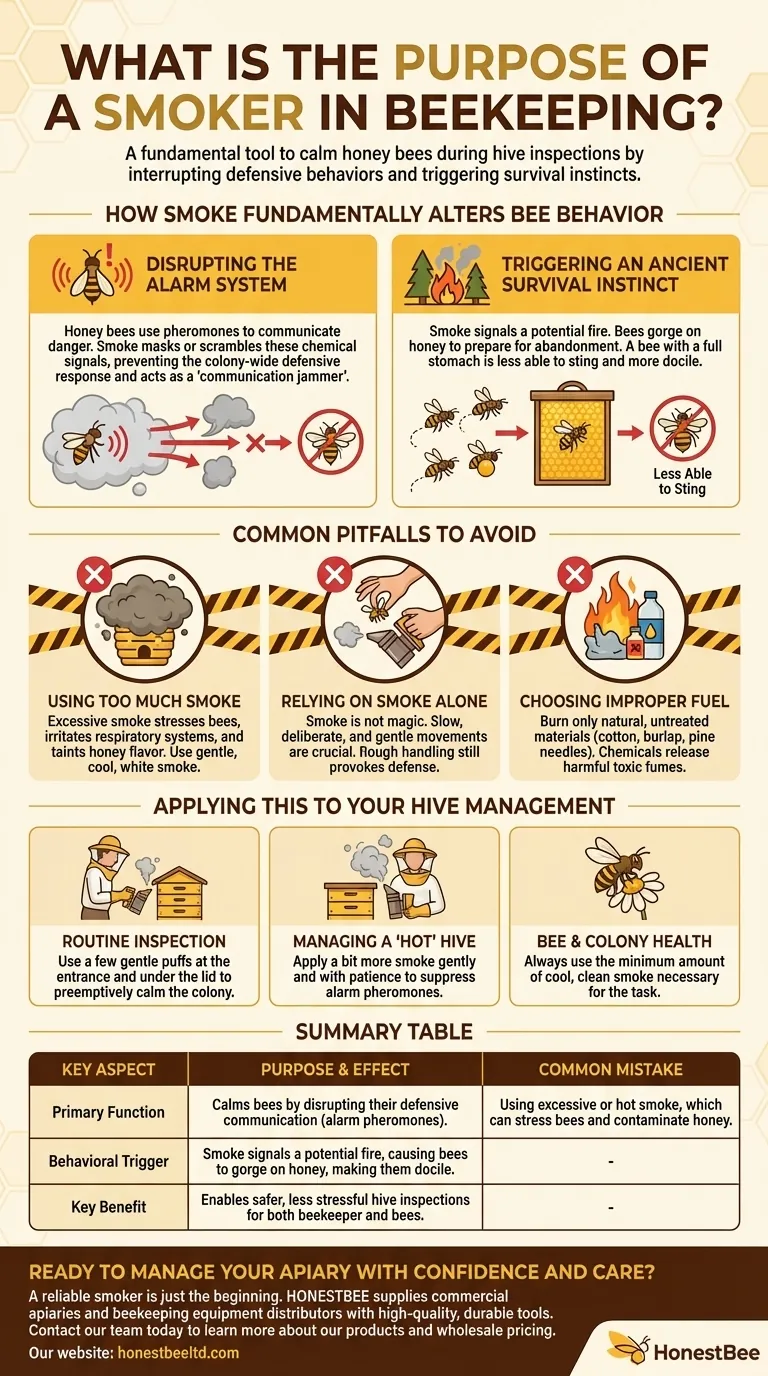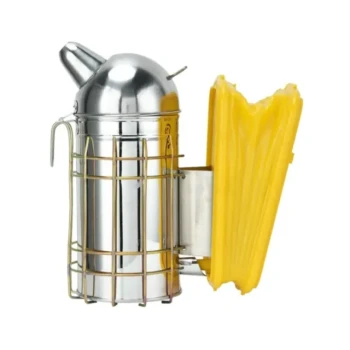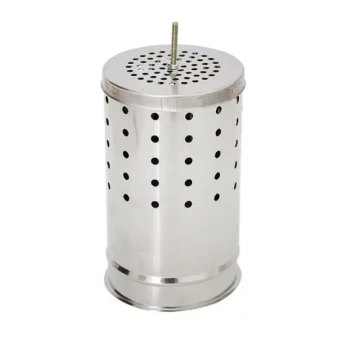A bee smoker is a fundamental tool used to calm honey bees during hive inspections. Its purpose is not to sedate the bees, but to interrupt their natural defensive behaviors by masking their primary method of communication and triggering a survival instinct. This makes managing the colony safer and less stressful for both the beekeeper and the bees.
The smoker's true function is to disrupt the bees' ability to communicate danger. By overwhelming their alarm pheromones with smoke, you prevent a colony-wide defensive response, making safe hive interaction possible.

How Smoke Fundamentally Alters Bee Behavior
To understand why a smoker is so effective, it's necessary to understand how a colony defends itself. The smoker works by targeting two core bee behaviors simultaneously.
Disrupting the Alarm System
Honey bees use chemical signals, or pheromones, to communicate. When a bee feels threatened or stings, it releases an alarm pheromone.
This pheromone acts as a beacon, alerting other guard bees in the colony to the specific location of the threat and triggering an immediate, coordinated defensive attack.
The smoke from the beekeeper's smoker effectively masks or scrambles this signal. It acts as a "communication jammer," preventing the alarm from spreading throughout the hive and stopping a defensive chain reaction before it starts.
Triggering an Ancient Survival Instinct
The presence of smoke triggers a deep-seated survival response in bees: the possibility of a forest fire.
When bees sense a potential fire, their priority shifts from defending the hive to preparing to abandon it and find a new home. To do this, they must take as much of their food source—honey—with them as possible.
In response to the smoke, bees will begin to gorge on honey. A bee with a full stomach is physically less able to flex its abdomen to sting and is generally more docile and preoccupied with the task of consuming honey.
Common Pitfalls to Avoid
While a smoker is essential, its improper use can be counterproductive or even harmful. Understanding its limitations is key to effective beekeeping.
Using Too Much Smoke
The goal is to use gentle wisps of cool, white smoke, not to fill the hive with thick clouds.
Excessive smoke can be overly stressful for the bees, irritate their respiratory systems, and may even taint the flavor of the honey.
Relying on Smoke Alone
A smoker is a tool to facilitate calm, not a magic wand to prevent all stings.
The beekeeper's own movements must be slow, deliberate, and gentle. Rough handling or crushing bees will still provoke a defensive response, regardless of how much smoke is used.
Choosing Improper Fuel
The fuel burned in a smoker should always consist of natural, untreated materials like cotton, burlap, pine needles, or dried leaves.
Using materials with chemicals, plastics, or accelerants can release toxic fumes that are harmful to the bees, the beekeeper, and can contaminate the honey and wax.
Applying This to Your Hive Management
Your use of the smoker should be intentional and adapted to the situation.
- If your primary focus is a routine inspection: Use a few gentle puffs at the hive entrance before opening it, and then a few more under the lid. This preemptively calms the colony.
- If your primary focus is managing a known "hot" hive: A bit more smoke may be needed, but it should still be applied gently and with patience to keep the alarm pheromones suppressed.
- If your primary focus is bee and colony health: Always use the minimum amount of smoke necessary to accomplish your task, ensuring it is cool and clean.
Ultimately, the bee smoker is a tool that allows for a more harmonious interaction between the beekeeper and the bees.
Summary Table:
| Key Aspect | Purpose & Effect |
|---|---|
| Primary Function | Calms bees by disrupting their defensive communication (alarm pheromones). |
| Behavioral Trigger | Smoke signals a potential fire, causing bees to gorge on honey, making them docile. |
| Key Benefit | Enables safer, less stressful hive inspections for both beekeeper and bees. |
| Common Mistake | Using excessive or hot smoke, which can stress bees and contaminate honey. |
Ready to manage your apiary with confidence and care?
A reliable smoker is just the beginning. HONESTBEE supplies commercial apiaries and beekeeping equipment distributors with the high-quality, durable tools needed for efficient and humane hive management. From smokers and protective gear to essential hive components, our wholesale-focused operations ensure you get the professional equipment your business depends on.
Let's discuss your apiary's needs. Contact our team today to learn more about our products and wholesale pricing.
Visual Guide

Related Products
- Stainless Steel Honey Bee Smoker Hive and Honeycomb Smoker for Beekeeping
- European Stainless Steel Bee Smoker for Honey Bee Hive
- Stainless Steel Bee Hive Smoker Beekeeping Smoker for Wholesale
- Economy Galvanized Beekeeping Honey Bee Smoker for Wholesale
- Premium Traditional Copper Bee Smoker with Bellows
People Also Ask
- What happens to bees when they sense smoke? Unlock the Secret to Calm Hive Inspections
- How long does it take to clean a bee smoker? From 15-Minute Quick Fix to 10-Hour Deep Clean
- What is the primary purpose of using smoke in beekeeping? Calm Bees for Safer Hive Management
- What is a bee smoker and how does it work? Master the Tool for Calm, Safe Hive Inspections
- What is a bee smoker and what is its primary purpose? Master Safe Hive Inspections



















